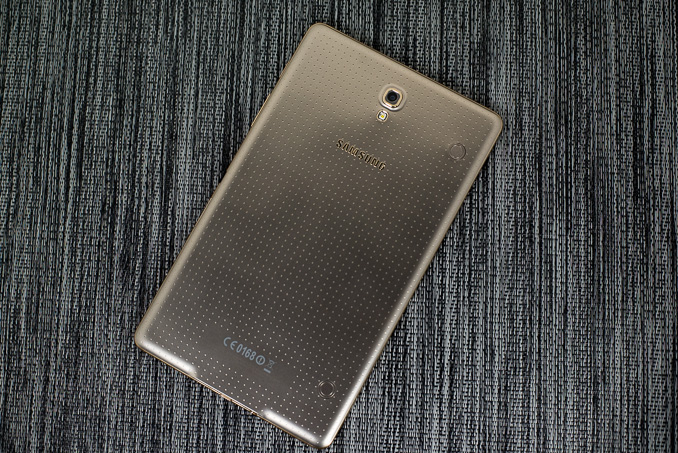Samsung Galaxy Tab S Review (10.5 & 8.4-inch)
by Anand Lal Shimpi on June 24, 2014 9:00 AM EST- Posted in
- Tablets
- Samsung
- Mobile
- Galaxy Tab S
Final Words
The Galaxy Tab S is easily the most compelling tablet family Samsung has ever released. The devices are incredibly thin, very light and boast displays that can be easily configured to be among the most accurate in the industry. In the Android tablet space it’s often a stretch charging $399 or $499, even for a flagship, given how good the Nexus line ends up being. With the Tab S, I think Samsung has something that’s worthy of a price premium over the more cost effective Android tablets.
The Galaxy Tab S, regardless of size, is easy to hold and has a screen that’s great to look at. These are two of the most important things to get right when building a tablet and the Tab S delivers on both.
The features around the edges are nice additions. The integrated fingerprint scanner works better on the tablet than it does on the phone, and is a decent time saver if you’ve got a long passcode. Having 2-stream 802.11ac support is nice as well, although the implementation isn’t as good as it is on the Galaxy S5. If you do have a Galaxy S5, having the ability to answer calls directly from your tablet is a neat feature.
The devices aren't perfect however. The Exynos 5420 SoC in both tablets is no longer class leading. CPU performance is reasonable but the GPU does seem to have issues keeping up with the high resolution display. If anything, Qualcomm’s Snapdragon 805 would probably have been a better fit for the tablets across the board. I suspect Exynos 5420 won out due to pricing, but as a result we end up with a tablet that has the dimensions and display of a flagship and an SoC that is simply good enough.
Battery life is either going to be amazing or below par depending on your usage model. If you spend a lot of time looking at web pages, you’ll find the high resolution AMOLED display to be a power liability. If however you mainly use your tablet to watch TV and movies, there’s literally no better option on the market today when it comes to battery life. Even the tiny 8.4-inch Galaxy Tab S managed to best all of the other tablets we’ve tested in video playback battery life, delivering over 15 hours on a single charge. Start browsing the web however and you’re looking at roughly half of that. It’s an interesting tradeoff for sure.
Overall the Galaxy Tab S feels like a solid reboot for Samsung’s tablet ambitions. The trick from here on out will be to continue to iterate the design without losing focus. A successor with a better SoC might be a good start. Perhaps Snapdragon 808/810 might be a good option next year, or an 805 based solution by the end of this year depending on how aggressive of a schedule Samsung sticks to for tablet releases going forward.












98 Comments
View All Comments
antiglobe - Sunday, October 26, 2014 - link
I think the updated model will more likely use the new Exynos used in Galaxy Alpha than a Snapdragon. Samsung can obviously reach higher profits by utilizing home made chips.the_ether - Tuesday, June 24, 2014 - link
So if I've understood correctly, the Samsung's screen isn't that great after all - at least when compared against the iPad Air. It has more pixels and supposedly better contrast (though that wasn't tested here) but what is displayed is not as accurate as the Air's Retina screen.nerd1 - Tuesday, June 24, 2014 - link
AMOLED has immense contrast and no display lag, both of which are not tested here.GC2:CS - Tuesday, June 24, 2014 - link
The smallest amount of ambient light washes out any contrast difference, so you can enjoy your AMOLED at night, especially watching horrors but otherwise it's hardly a problem.What about that display lag ? Honestly I don't know what it is exactly, but I think is rather bad as I noticed flickering on many AMOLED displays...
nerd1 - Tuesday, June 24, 2014 - link
Smallest amount of ambient light will hamper any display color accuracy too, then all displays are born equal?the_ether - Tuesday, June 24, 2014 - link
Shouldn't be as sensitive as you imply. The screen is an emissive device, not reflective, so the ambient light would have to be strong enough to interfere with the light from the screen.theduckofdeath - Tuesday, June 24, 2014 - link
Hyperbole much, GC2:CS?dwade123 - Wednesday, June 25, 2014 - link
no lag huh. Nice BS.GC2:CS - Tuesday, June 24, 2014 - link
Yeah exactly ! The problem for samsung is that the iPad Air screen is the same as the screen of the new iPad (2012) just lower power and higher brightness... And this is 2014. Anand's numbers are painting these in a very good picture, but in reality I found this: https://m.youtube.com/watch?v=SjYuNzFRIagBlues are especially over saturated on the 10,5 just as that horrible sub pixel arrangement implies.
bji - Tuesday, June 24, 2014 - link
How can you possibly tell anything about a display when viewing a video of it on your own display, which completely alters the perceived characteristics of the display being evaluated?I have an idea. Let's film both displays in black and white and then do a comparison to try to see which display has better colors. It would be just about as viable a means of comparing displays as the video you linked.